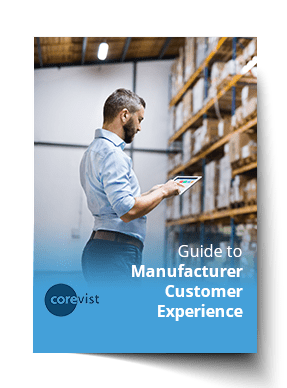Manufacturers must address customer experience like never before.
First published Oct 1, 2019. Updated July 12, 2023.
These days, every B2B industry is evaluating customer experience—and manufacturing is no different. As buyers become more and more comfortable with online interactions in their lives as consumers, they bring those same expectations to work when they buy from manufacturers.
So what does it take to create a great customer experience in manufacturing?
Since there are many answers to that question, we’ve provided the top 7 pain points below which we hear from manufacturers and their customers in all verticals. Click on one that resonates with you, and we’ll give you some ideas on how to address the situation.
Here are the Top 7 Pain Points in Manufacturing Customer Experience.
Click to jump:
1. Customers say you’re hard to do business with
2. Customers want an Amazon-like experience
3. Customers need a self-service digital portal, but you can’t manage it in-house
4. Customers are frustrated because orders take too long to fulfill
5. Customers are complaining because they can’t see real-time inventory in the portal
6. Customers have abandoned your online experience
7. Customers need more transparency on their account status, order status, and shipment status
8. Customers can’t order from your digital catalog
9. Customers have to use EDI for routine inquiries
1. Customers say you’re hard to do business with
Too many manufacturers fall into this category. Their customer experience involves phone calls with long hold times or email-based ordering processes. Maybe they prefer to take orders via EDI, but smaller customers can’t invest in that infrastructure, so they’re left with 1990s technology for order placement, order tracking, and invoice tracking. When orders get rekeyed into the ERP, customer service reps find errors that require manual callbacks. An order isn’t really “placed” until a customer has gone through that process–perhaps several times.
Generally, this frustrating customer experience emerges in all parts of the buying journey, from inventory lookups, to accurate price quotes, to order placement, to invoice payments and beyond. (We’ll cover each of these in detail below.)
SOLUTION: A self-service customer portal
For manufacturers, crafting a great customer experience means thinking “digital first.” The customer should be able to perform every task in their journey within a B2B portal.
Of course, that digital customer experience can take many forms. Organizations are innovating with manufacturing customer portals, B2B ecommerce solutions, Online Order Tracking, and more, depending on the needs of their customer base.
For more insight, download our Ultimate Guide to Manufacturer Customer Experience.

FREE Guide:
Manufacturer Customer Experience
How do you craft a great customer experience for dealers & distributors?
Manufacturers are scrambling to shift their customer experience to self-service web portals (or to improve their self-service option if they already have one).
Cover all your bases in customer experience with our Ultimate Guide.
2. Customers want an Amazon-like experience
When it comes to manufacturing customer experience, you’ll find customers using a lot of different terms to indicate the same thing. In reality, if customers are saying they want an Amazon-like experience, they’re really just saying you’re hard to do business with—same as point 1.
A B2B portal with an Amazon-style experience makes you easier to do business with. That’s because it’s made for browsing, discovery, and self-service. So if you address this pain point, you address #1, too.
What all goes into an Amazon-style customer experience for manufacturers? Here are some top things your customers are looking for:
- Rich content for products (i.e. multiple photos, videos, customer testimonials, spec sheets, documentation, and more
- Intelligent search that gets them straight to the right product(s) without a lot of digging.
- Product recommendations that help them discover new products related to the one they’re looking at.
- Intelligent SKU substitution for discontinued products or permissions-based SKU errors.
- Real-time inventory availability so they know whether they can trust you to get the order to them on time. (More on this below.)
- Accurate contract pricing so they know how much an order will actually cost before placing it.
- And more
SOLUTION: Launch a manufacturer-branded customer experience that borrows from the best of Amazon
If your buyers want an Amazon-style customer experience, you’re not alone. Corevist Commerce Cloud is designed with the needs of your dealers and distributors in mind. They get rich content, personalization, 100% accurate pricing, real-time inventory, and more—everything driven by their personalized SAP business rules.
Shown: Product listing in Corevist Commerce Cloud with 100% accurate, customer-specific product data driven by SAP business rules in real time.
3. Customers need a self-service digital portal, but you can’t manage it in-house
This is one of the prime challenges we hear from manufacturers. “We know we need to improve our customer experience with a B2B portal. But we don’t have the resources to build it in-house, and we don’t want to become a software development company.”
That worry isn’t baseless, either. As Forrester has reported, SAP hybris (now Commerce Cloud) requires a team of 12 full-time employees to keep it running smoothly in a B2B scenario.
In other words, you’ll essentially need to launch a new company inside your company—a micro-division that manages and supports your digital customer experience from a technical perspective.
Unfortunately, that’s just not realistic for many manufacturers.
SOLUTION: Choose a managed provider for your B2B portal
A managed solution is ideal for manufacturers who can’t support a digital portal in-house but definitely need to transform their customer experience. With one vendor taking care of your entire B2B portal infrastructure, you can focus on managing your business.
This is the thinking behind all Corevist Editions. We include our prebuilt, real-time SAP integration in every solution we offer. It’s how we empower manufacturers to revolutionize customer experience without engaging additional IT resources.
4. Customers are frustrated because orders take too long to fulfill
It’s not enough to have a B2B portal if it’s not integrated to SAP ERP. With a disconnected ecommerce site, someone will have to take ecommerce orders and type them into the ERP system. No big deal if you get a few orders a day. But at scale, for global manufacturers with multiple divisions, a disconnected portal or B2B ecommerce solution can spell disaster.
Think of it like this: How do you deal with order errors? If the ecommerce store has no visibility into business rules and real-time inventory, it may give the customer the impression that their order was flawless and will be fulfilled promptly—when in fact, due to errors in SKU permissions, pricing, shipping charges, or inventory availability, the order will have to go on manual block, requiring follow-up from a CSR (customer service representative).
Even if you don’t give customers total visibility into these problems, they’ll still create delays in the order fulfillment process. That’s a bad customer experience for manufacturers. Depending on how commoditized the products are, it may drive customers away from you entirely—and to the competition.
SOLUTION: Launch self-serve online ordering with automated business rules enforced (reducing or eliminating the need for manual intervention)
If you have broken order fulfillment processes, a B2B ecommerce solution with real-time ERP business rules is critical to reducing customer frustration. A platform like Corevist Commerce Cloud simulates orders against your SAP ERP system and returns intelligent error messages based on your real SAP business rules. These messages explain to the customer what they need to do to create an error-free order.
This is a crucial part of the digital customer experience for manufacturers. If your customers can’t actually check prices and availability online or place an error-free order, then the solution isn’t actually self-service—it’s just creating friction.
Learn more in our FREE Guide to Manufacturer Customer Experience.
DOWNLOAD NOW:
Ultimate Guide to Manufacturer Customer Experience
How do you craft a great customer experience for dealers & distributors?
The key is to empower your channel partners to interact with SAP ERP in real time, through a fully-integrated self-service solution.
Learn more in our Ultimate Guide.

5. Customers are complaining because they can’t see real-time inventory in the portal
In both B2B and B2C, customer experience depends on reliability–and this is especially true for manufacturers. If your web portal isn’t reliable, customers won’t use it.
Inventory availability (and/or customer-specific ATP calculation) is key to a seamless customer experience for a manufacturer. When buyers are putting together an order, they want to know how much product is in stock. Whether you’re showing them the literal, total inventory, or a fractional ATP calculation personalized to their account, you need to show them something.
Since inventory data lives in your ERP (and gets updated there in real time), your B2B ecommerce portal needs to communicate with SAP to give customers that information.
SOLUTION: Choose a customer portal solution that displays real-time inventory
For manufacturers, an online customer experience demands real-time inventory availability. When you choose a solution that’s built around a real-time integration to your SAP ERP system, you can show your users the real-time inventory/ATP which they need to place orders with confidence.
6. Customers have abandoned your online experience
Early adopters of web portal technology often encounter a unique problem. Customers have abandoned the old B2B ecommerce solution and gone back to phone/fax/email ordering—or worse, turned to the competition, who does have a beautiful, functional online customer experience.
The “Amazon effect” has raised expectations for all parties involved, and if your older web portal doesn’t support the kind of functionality which users now expect, they may get too frustrated to keep using it. Here are some things which are often lacking in older manufacturing customer experiences:
- No product photos
- No product descriptions
- No related/recommended products
- Hard to look up products by category number
- Difficult checkout process
- No credit card acceptance
- No visibility into account history/standing
SOLUTION: Update your B2B ecommerce portal with the functionality which customers desperately need (and launch a dedicated customer relationship campaign to aid adoption)
If you find yourself in this situation, you’ll need to play a bit of catchup. The first thing is to add customer-critical functionality to your existing web portal (or replace the portal with a new solution if necessary).
But that’s not enough. You’ll also need to address the fact that your old solution wasn’t meeting customer needs and may have created lingering frustration. You’ll need to demonstrate empathy through focused communications with customers to show them that you’ve heard their concerns, and you’ve launched a new customer experience based on that feedback.
7. Customers need more transparency on their account status, order status, and shipment status
If your B2B portal doesn’t provide visibility into account history/status (or if you don’t have a B2B portal at all), your customer experience isn’t optimized. If customers have to call in or send an email to reprint documents, get order confirmation, or track order status, you’re adding friction that your users don’t need.
SOLUTION: Launch an online customer experience with self-service account management built in
A customer portal should allow users to manage their accounts through self-service. Reprinting documents, tracking orders, monitoring order status—none of this should require manual intervention from your Customer Service department.
That’s why Corevist offers real-time SAP integration for self-serve account management. It ensures that your users can track shipments and order status, plus access all the historical information associated with their account—even for orders that weren’t placed through Corevist.
8. Customers can’t order from your digital catalog
It’s great to have a digital catalog. It gives your customers a single source of truth for your offerings.
The problem arises when you have a digital catalog with no ordering capabilities.
85% of B2B customers will abandon a supplier with a bad digital experience. If they have to pick up the phone to place an order after browsing your catalog, or if they have to log into a different system to place the order, then you have friction in your customer experience.
SOLUTION: A unified customer experience for catalog and online ordering
A digital catalog should never be separated from order placement. When you bring these two functions together under one “roof,” you create a seamless customer experience. Buyers can get in, build an order, place it, and get on with their day.
9. Customers have to use EDI for catalog requests, inventory checks, & tracking
Granted, some customers will always use EDI for order placement. Your biggest accounts probably have their workflows in place for procurement.
But what about routine requests for information?
No one wants to send an EDI 846 (inventory check) or an EDI 832 (catalog pricing request). In the age of Amazon, people expect this information to be available through self-service.
If your customers have to use EDI to get routine information, chances are, you have an opportunity to improve your customer experience.
SOLUTION: A self-service portal for routine lookups
Even EDI customers appreciate the ability to check inventory, track orders and invoices, and pay off invoices online. It’s simply more convenient than alternative workflows. It allows them to get in, get out, and get on with their day.

Thinking about your journey?
Let’s put a stake in the ground.
Schedule a consultation with an SAP specialist, and let’s accelerate your time to value.




